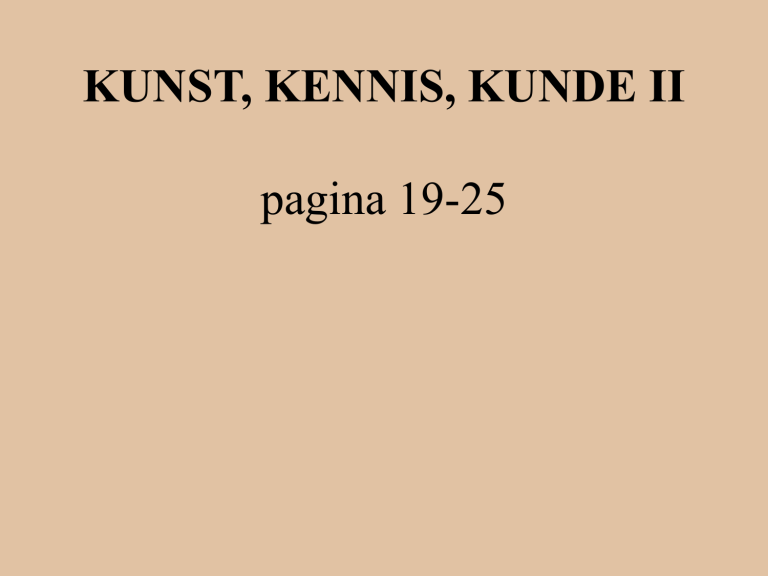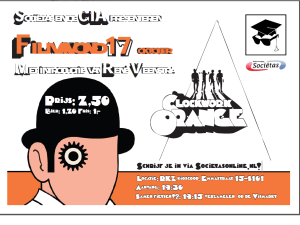
KUNST, KENNIS, KUNDE II
pagina 19-25
Het
binnenste
buiten…
Katharine du Tiel
“… San Francisco-based photographer Katherine Du
Tiel creates images by projecting anatomical
illustrations onto living bodies and other threedimensional anatomical models. The resulting images
play with the separation between anatomical
representation and reality. In one image, a textbook
image of a back is projected onto a model’s side. In
another, the muscular structure of a hand appears on
the surface of the skin rather than under it. …”
• Welke motieven zijn er aan te voeren om
anatomische tekeningen, preparaten en
secties al of niet te rekenen tot het domein
van de beeldende kunst?
Invloed van
medische
beeldvormende
middelen
op de moderne
kunst
Gabriele Leidloff
“…Leidloff plays ironically with the iconology of the
Dance of Death: not a row of skeletons to remind us
of our unavoidable mortality and, at the same time, of
the decaying material substance we are made of, but
sex dolls, mannequins and life and death masks, all
rendered so highly sensual and carnal that they could
almost be touched. The spectacle of death cohabits
with the celebration of life and sensuality as it
happened in the early days of radiography. The
'memento mori' in Leidloff's images is curiously
disguised through the affirmation of life by means of
inanimate materials: maybe an intuitive glimpse into
the future of our posthuman bodies?…”
Orlan
“…Je huid is bedrieglijk, je
hebt nooit de huid van wat je
bent, je kunt de huid van een
krokodil hebben, maar in
werkelijkheid een
schoothondje zijn, de huid
van een engel hebben, maar
een jakhals zijn, de huid van
een donkere, maar een blanke
zijn, de huid van een vrouw,
maar een man zijn.
Marc Quinn
Bestudeer stencils:
* Marc Quinn – Lichaam en
Geest
* De emotionele ontgifting
van Marc Quinn
Garden (2000) by Marc Quinn is a real botanical
garden, full of plants and flowers from all over the
world. They are displayed in full bloom, and are
potentially eternal: the nearly 1000 specimens are
immersed in twenty-five tons of liquid silicone kept at
a constant temperature of -80˚ Celsius. They can
neither grow or perish, an unreal dimension that
cannot exist unless produced artificially. And though
frozen, they produce an enchantment of continuous
spring. Marc Quinn: “The flowers, when they freeze,
become pure image. They become an image of
perfect flower, because in reality their matter is dead
and they are suspended in a state of transformation
between pure image and pure matter.”
Mona Hatoum
Corps étranger (Foreign body) is a video installation. From outside it is a
white circular "room" with two narrow openings. Inside it is dark, speakers
enclosed in the walls lined in acoustic material reproduce the sound of
heartbeat and breath.
On the floor is projected, on a circular screen that leaves little space for
walking, a video of the outside and inside of a body (the artist's). A micro
camera travels around the surface and enters every time it encounters an
orifice. The viewer can either stay very close to the wall or walk across the
screen and have the images projected on him/her.
Here, the issue is the body and its being dominated, opened and
disciplined by the gaze and institutions (here materialised in modern
technology). However, voyeurism and discipline are not negated, but
exploited against themselves. The viewer is empowered as the voyeur, the
classical aesthetic relation of the viewer, distant and detached, gazing
down at the object is here literally, materially, true. But the viewer is also
inside the viewed, the body could be theirs, or they could be the camera.
All the structure suggests identification both with the body - the circular
space recalling body channels - and with the camera - the circular
screen alluding to the eye form; the sound is there to increase the sense
of total immersion. Visual and corporeal merge and vision becomes - or
re-becomes - an all-round bodily sensation. Something apparently
voyeuristic is used to engage the whole sensorium and provoke a "gut"
reaction. An image is used against images: this is the strategy, the
critique, that functions because it is internal.
Hatoum is thus resisting not only oppression and objectification but also
aestheticization: Corps étranger is not any more a body transformed in
an image, as much as an image that takes us back to the very
physicality of the body. In this sense her work is opposed to Orlan's, the
French artist who has made of the transformation of her face a work of
art, claiming to be flesh becoming an image. (Omnipresence series: a
series of surgical operation through which Orlan is reshaping her face,
partly according to the features of art masterpieces. The operations
themselves, directed by the artist under local anaesthesia and
networked live around the world are the resulting art work). Such a total
aestheticization, however, just reveals that there is nothing behind (that)
image.
• Entrails transforms an age-old textile form -- the carpet
-- with unsettling effect. Hatoum's carpets extend a
visual invitation to walk or lie down, but the idea of
actual contact with the sticky rubber is repellent. The
body is often present in Hatoum's work, whether
represented or suggested. Entrails evokes our bodily
existence at "gut level," offering a cautionary tale
about finding false comfort in something that seems
familiar. Originating, as the artist says, from "a place of
not belonging," her work refuses to offer a safe haven
for peaceful contemplation. Instead, deceptively
elegant, mutely aggressive, it demands that we
experience the often uncomfortable realities and
paradoxes that define our existence.
Stelarc
Günther von Hagens
“Bodies – the Exhibit”
Beurs van Berlage
Amsterdam, t/m 14 april 2007
• Hoe maken kunstenaars van onze tijd het
onderzoek van het lichaam en van
lichaamsprocessen tot uitgangspunt van een
artistieke productie?












